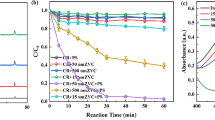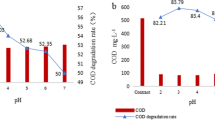Abstract
Rhodamine B (RhB) in dye wastewater was degraded by zero-valent iron (ZVI) activated persulfate (PS). ZVI/PS system can produce strong oxidizing SO4−· and ·OH, which can degrade RhB. The reaction kinetics models of the ZVI/PS system and ZVI/PS/CA system were explored. The degradation efficiency and influence of PS activated by ZVI as activator on RhB and the strengthening effect of CA on the ZVI/PS system were analyzed. The degradation efficiency of RhB was analyzed if ZVI was added in batches, and the valence change of Fe was monitored to verify the results of ZVI experiment. And, the leading free radicals in the ZVI/PS system and the possible degradation paths of RhB were analyzed. The results showed that the degradation process of RhB in the ZVI/PS system and ZVI/PS/CA system was in line with apparent first-order kinetics (R2 = 0.996) and second-order kinetics (R2 = 0.918), respectively. In the ZVI/PS system, the optimum experimental conditions were 12 mmol·L−1 PS, 0.9 g·L−1 ZVI and initial pH = 5, the degradation rate of RhB was the highest at 96.54%, and SO4−· played a leading role. The effects of various experimental factors on the degradation rate of RhB were as follows: ZVI dosage > initial pH > PS dosage. The ZVI/PS system can be strengthened with proper CA dosage, and the degradation rate of RhB is the highest when the dosage of CA is 0.1 mmol·L−1. The results of batch ZVI experiments showed that the degradation efficiency of RhB was not significantly improved.
Graphical Abstract












Similar content being viewed by others
Data Availability
All data generated or analyzed during this study are included in this published article and its supplementary information files.
References
Aftab S, Shabir T, Shah A, Nisar J, Shah I, Muhammad H, et al. (2022). Highly efficient visible light active doped zno photocatalysts for the treatment of wastewater contaminated with dyes and pathogens of emerging concern. Nanomaterials, 12, https://doi.org/10.3390/nano12030486
Akram M, Chakrabarti S. (2022). Mechanism and kinetic model of the oxidative degradation of rhodamine b dye in aqueous solution by ultrasound-assisted fenton's process. International Journal of Environment and Waste Management, 29, https://doi.org/10.1504/IJEWM.2022.120641
Chen, S. Y., Yan, C. X., Nie, M. H., Wu, L. L., Ding, M. J., & Wang, P. (2022). Hydrogen sulfite promoted the activation of persulfate by mu m fe2+ for bisphenol a degradation. Environmental Science and Pollution Research, 29, 85185–85201. https://doi.org/10.1007/s11356-022-21801-x
Chen, Q., Zhou, M. H., Pan, Y. W., & Zhang, Y. (2023). Ligand-enhanced zero-valent iron for organic contaminants degradation: A mini review. Processes, 11, 16. https://doi.org/10.3390/pr11020620
Deng, J., Shao, Y., Gao, N., Deng, Y., Tan, C., & Zhou, S. (2014). Zero-valent iron/persulfate(fe-0/ps) oxidation acetaminophen in water. International Journal of Environmental Science and Technology, 11, 881–890. https://doi.org/10.1007/s13762-013-0284-2
Dong, H. R., He, Q., Zeng, G. M., Tang, L., Zhang, L. H., Xie, Y. K., et al. (2017). Degradation of trichloroethene by nanoscale zero-valent iron (nzvi) and nzvi activated persulfate in the absence and presence of edta. Chemical Engineering Journal, 316, 410–418. https://doi.org/10.1016/j.cej.2017.01.118
Dong, J. Q., Sheng, X. X., Liu, Y. L., Wang, P., Lu, Z. P., Sui, Q., et al. (2022). Insights into the enhanced fluoranthene degradation in citric acid coupled fe(ii)-activated sodium persulfate system. Water Supply, 22, 4822–4838. https://doi.org/10.2166/ws.2022.190
Fang, G. D., Chen, X. R., Wu, W. H., Liu, C., Dionysiou, D. D., Fan, T. T., et al. (2018). Mechanisms of interaction between persulfate and soil constituents: Activation, free radical formation, conversion, and identification. Environmental Science and Technology, 52, 14352–14361. https://doi.org/10.1021/acs.est.8b04766
Graca, C. A. L., Fugita, L. T. N., de Velosa, A. C., & Teixeira, A. (2018). Amicarbazone degradation promoted by zvi-activated persulfate: Study of relevant variables for practical application. Environmental Science and Pollution Research, 25, 5474–5483. https://doi.org/10.1007/s11356-017-0862-9
Iqbal J, Shah NS, Khan ZU, Rizwan M, Murtaza B, Jamil F, et al. (2022). Visible light driven doped ceo2 for the treatment of pharmaceuticals in wastewater: A review. Journal of Water Process Engineering, 49, https://doi.org/10.1016/j.jwpe.2022.103130
Ji, Y. F., Ferronato, C., Salvador, A., Yang, X., & Chovelon, J. M. (2014). Degradation of ciprofloxacin and sulfamethoxazole by ferrous-activated persulfate: Implications for remediation of groundwater contaminated by antibiotics. Science of the Total Environment, 472, 800–808. https://doi.org/10.1016/j.scitotenv.2013.11.008
Ji, Y. F., Dong, C. X., Kong, D. Y., Lu, J. H., & Zhou, Q. S. (2015). Heat-activated persulfate oxidation of atrazine: Implications for remediation of groundwater contaminated by herbicides. Chemical Engineering Journal, 263, 45–54. https://doi.org/10.1016/j.cej.2014.10.097
Li, S. L., Wang, W., Liang, F. P., & Zhang, W. X. (2017). Heavy metal removal using nanoscale zero-valent iron (nzvi): Theory and application. Journal of Hazardous Materials, 322, 163–171. https://doi.org/10.1016/j.jhazmat.2016.01.032
Li, Y. T., Li, D., Lai, L. J., & Li, Y. H. (2020). Remediation of petroleum hydrocarbon contaminated soil by using activated persulfate with ultrasound and ultrasound/fe. Chemosphere, 238, 8. https://doi.org/10.1016/j.chemosphere.2019.124657
Li, S. Y., Guo, R. X., Li, B. B., Liang, Y. P., Wang, Z. Y., & Qu, R. J. (2023). Kinetics and mechanism studies of efficient degradation of 1-hexyl-3-methylimidazolium by zero-valent iron activated persulfate. Chemical Engineering Journal, 460, 12. https://doi.org/10.1016/j.cej.2023.141575
Monteagudo, J. M., El-taliawy, H., Duran, A., Caro, G., & Bester, K. (2018). Sono-activated persulfate oxidation of diclofenac: Degradation, kinetics, pathway and contribution of the different radicals involved. Journal of Hazardous Materials, 357, 457–465. https://doi.org/10.1016/j.jhazmat.2018.06.031
Nie, M. H., Yan, C. X., Li, M., Wang, X. N., Bi, W. L., & Dong, W. B. (2015). Degradation of chloramphenicol by persulfate activated by fe2+ and zerovalent iron. Chemical Engineering Journal, 279, 507–515. https://doi.org/10.1016/j.cej.2015.05.055
Oh, S. Y., Kim, H. W., Park, J. M., Park, H. S., & Yoon, C. (2009). Oxidation of polyvinyl alcohol by persulfate activated with heat, fe2+, and zero-valent iron. Journal of Hazardous Materials, 168, 346–351. https://doi.org/10.1016/j.jhazmat.2009.02.065
Olmez-Hanci, T., & Arslan-Alaton, I. (2013). Comparison of sulfate and hydroxyl radical based advanced oxidation of phenol. Chemical Engineering Journal, 224, 10–16. https://doi.org/10.1016/j.cej.2012.11.007
Premalatha, N., & Miranda, L. R. (2022). A magnetic separable 3d hierarchical bioi/rgo/fe3o4 catalyst for degradation of rhodamine b under visible light: Kinetic studies and mechanism of degradation. Mater Sci Eng B-Adv Funct Solid-State Mater, 276, 17. https://doi.org/10.1016/j.mseb.2021.115576
Rasheed, T., Bilal, M., Iqbal, H. M. N., Shah, S. Z. H., Hu, H. B., Zhang, X. H., et al. (2018). Tio2/uv-assisted rhodamine b degradation: Putative pathway and identification of intermediates by uplc/ms. Environmental Technology, 39, 1533–1543. https://doi.org/10.1080/09593330.2017.1332109
Rastogi, A., Ai-Abed, S. R., & Dionysiou, D. D. (2009a). Sulfate radical-based ferrous-peroxymonosulfate oxidative system for pcbs degradation in aqueous and sediment systems. Appl Catal B-Environ, 85, 171–179. https://doi.org/10.1016/j.apcatb.2008.07.010
Rastogi, A., Al-Abed, S. R., & Dionysiou, D. D. (2009b). Effect of inorganic, synthetic and naturally occurring chelating agents on fe(ii) mediated advanced oxidation of chlorophenols. Water Research, 43, 684–694. https://doi.org/10.1016/j.watres.2008.10.045
Rodriguez, S., Santos, A., & Romero, A. (2017). Oxidation of priority and emerging pollutants with persulfate activated by iron: Effect of iron valence and particle size. Chemical Engineering Journal, 318, 197–205. https://doi.org/10.1016/j.cej.2016.06.057
Sharma, G., Dionysiou, D. D., Sharma, S., Kumar, A., Al-Muhtaseb, A. H., Naushad, M., et al. (2019). Highly efficient sr/ce/activated carbon bimetallic nanocomposite for photoinduced degradation of rhodamine b. Catalysis Today, 335, 437–451. https://doi.org/10.1016/j.cattod.2019.03.063
Wang, C. W., & Liang, C. J. (2014). Oxidative degradation of tmah solution with uv persulfate activation. Chemical Engineering Journal, 254, 472–478. https://doi.org/10.1016/j.cej.2014.05.116
Wang, S. Z., & Wang, J. L. (2018). Trimethoprim degradation by fenton and fe(ii)-activated persulfate processes. Chemosphere, 191, 97–105. https://doi.org/10.1016/j.chemosphere.2017.10.040
Wang, B. W., & Wang, Y. (2022). A comprehensive review on persulfate activation treatment of wastewater. Science of the Total Environment, 831, 24. https://doi.org/10.1016/j.scitotenv.2022.154906
Wang, X., Wang, L. G., Li, J. B., Qiu, J. J., Cai, C., & Zhang, H. (2014). Degradation of acid orange 7 by persulfate activated with zero valent iron in the presence of ultrasonic irradiation. Separation and Purification Technology, 122, 41–46. https://doi.org/10.1016/j.seppur.2013.10.037
Wang, J. Z., Huang, D., Chen, F. X., Chen, J. H., Jiang, H. Y., Zhu, Y. F., et al. (2023). Rapid redox cycling of fe(ii)/fe(iii) in microdroplets during iron-citric acid photochemistry. Environmental Science and Technology, 57, 4434–4442. https://doi.org/10.1021/acs.est.2c07897
Wei, X. Y., Gao, N. Y., Li, C. J., Deng, Y., Zhou, S. Q., & Li, L. (2016). Zero-valent iron (zvi) activation of persulfate (ps) for oxidation of bentazon in water. Chemical Engineering Journal, 285, 660–670. https://doi.org/10.1016/j.cej.2015.08.120
Yang, J. J., Zhu, H. Q., Peng, Y., Li, P. X., Chen, S. Y., Yang, B., et al. (2020). Photocatalytic performance and degradation pathway of rhodamine b with ts-1/c3n4 composite under visible light. Nanomaterials, 10, 15. https://doi.org/10.3390/nano10040756
Zeng, G. L., Yang, R. M., Fu, X. R., Zhou, Z. Y., Xu, Z. Q., Zhou, Z. K., et al. (2021). Naphthalene degradation in aqueous solution by fe(ii) activated persulfate coupled with citric acid. Separation and Purification Technology, 264, 9. https://doi.org/10.1016/j.seppur.2021.118441
Zou, X. L., Zhou, T., Mao, J., & Wu, X. H. (2014). Synergistic degradation of antibiotic sulfadiazine in a heterogeneous ultrasound-enhanced fe-0/persulfate fenton-like system. Chemical Engineering Journal, 257, 36–44. https://doi.org/10.1016/j.cej.2014.07.048
Acknowledgements
Thanks to the Program of Science and Technology of Sichuan Province of China for supporting this article. And thanks to the Opening Project of Oil & Gas Field Applied Chemistry Key Laboratory of Sichuan Province.
Funding
This work was supported by the Program of Science and Technology of Sichuan Province of China under grant 2021ZYD0012, 2022NSFSC0532. And this work was supported by the Opening Project of Oil & Gas Field Applied Chemistry Key Laboratory of Sichuan Province (Grant No.YQKF202209).
Author information
Authors and Affiliations
Contributions
YL: Supervision, Conceptualization, Writing-Review, Editing. HL: Conceptualization, Investigation, All experiments, Writing-Original Draft. XL: Supervision, Review. XL: Validation. WD: (Postgraduate) did Data curation. JC: (Postgraduate) did Investigation.
Corresponding author
Ethics declarations
Conflict of Interest
The authors declare that they have no conflict of interest.
Additional information
Publisher's Note
Springer Nature remains neutral with regard to jurisdictional claims in published maps and institutional affiliations.
Supplementary Information
Below is the link to the electronic supplementary material.
Rights and permissions
Springer Nature or its licensor (e.g. a society or other partner) holds exclusive rights to this article under a publishing agreement with the author(s) or other rightsholder(s); author self-archiving of the accepted manuscript version of this article is solely governed by the terms of such publishing agreement and applicable law.
About this article
Cite this article
Li, Y., Liu, H., Li, X. et al. Study on the Efficiency of Zero-Valent Iron Activated Persulfate Degradation of Rhodamine B and Citric Acid Enhancement. Water Air Soil Pollut 235, 181 (2024). https://doi.org/10.1007/s11270-024-06987-9
Received:
Accepted:
Published:
DOI: https://doi.org/10.1007/s11270-024-06987-9




